1996 PONTIAC GRAND-AM engine overheat
[x] Cancel search: engine overheatPage 3 of 356
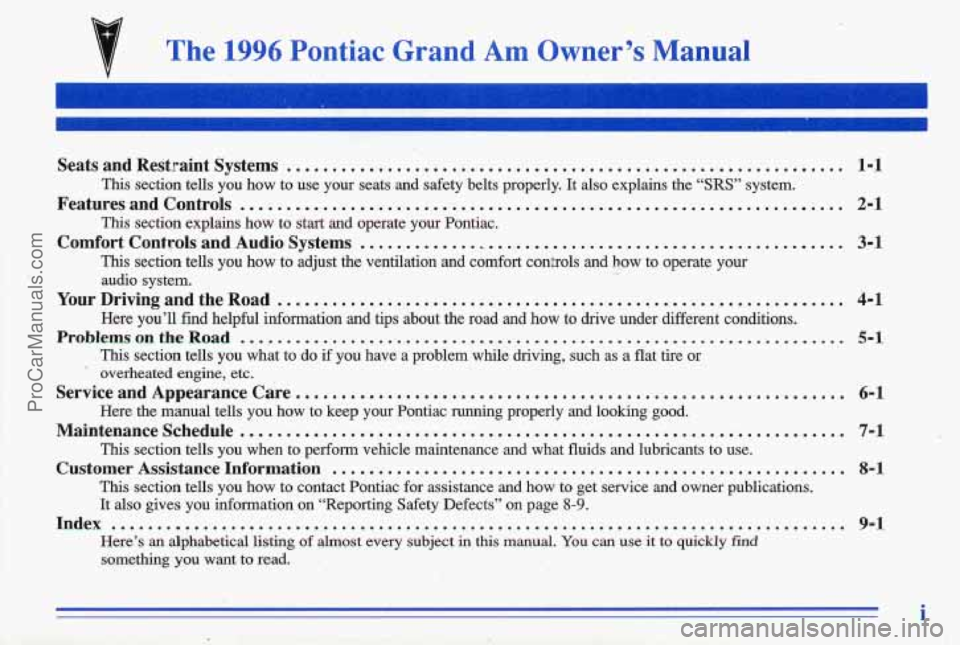
The 1996 Pontiac Grand Am Owner’s Manual
Seats and Restraint Systems ............................................................. 1-1
Features and Controls .................................................................. 2-1
Comfort Controls and Audio Systems ..................................................... 3-1
This section tells you how to use your seats and safety belts properly. It also explains the “SRS” system.
This section explains how to start and operate your Pontiac.
This section tells you how to adjust the ventilation
and comfort conkols and how to operate your
audio system.
Here you’ll find helpful information and tips about the road\
and how to drive under different conditions.
This section tells you what to do if you have a problem while driving, such as a flat tire or
Your Driving and the Road ............................................................... 4-1
ProblemsontheRoad .................................................................. 5-1
’ overheated engine, etc.
Service and Appearance Care ............................................................ 6-1
Maintenanceschedule.................................................... \
.............. 7-1 , ., ,(
Customer Assistance Information ........................................................ 8-1
Here the manual tells you how to keep your Pontiac running pr\
operly and looking good.
This section tells you when
to perform vehicle maintenance and what fluids and lubricants to use.
This section tells you how to contact Pontiac for assistance and how to get serv\
ice and owner publications.
It also gives you information on “Reporting Safety Defects” o\
n page
8-9.
Here’s an alphabetical listing of almost every subject in this manual. You can use it to quickly find
something you want to read.
Index ........................................................................\
........ 9-1
i
ProCarManuals.com
Page 73 of 356
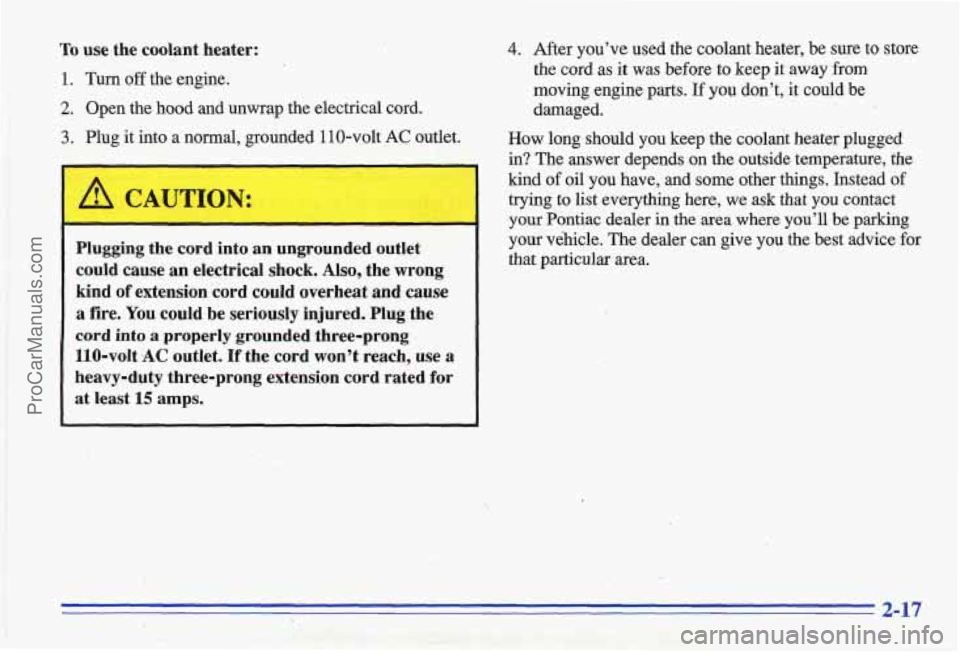
To use the coolant heater:
1. Turn off the engine.
2. Open the hood and unwrap the electrical cord.
3. Plug it into a normal, grounded 110-volt AC outlet.
1 A CAUTION:
Plugging the cord into an ungrounded outlet
could cause an electrical ,shock. Also, the wrong
kind
of extension cord could overheat and cause
a fire. You could be seriously injured. Plug the
cord into
a properly grounded three-prong
110-volt
AC outlet. If the cord won't reach, use a
heavy-duty three-prong extension cord rated for
at least 15 amps.
,-.. . . . 4.8 ..
4. After you've used the coolant heater, be sure to store
the cord as it was before
to keep it away from
moving engine parts. If you don't, it could be
damaged.
How long should you keep$he coolarit heater plugged
in? The answer depends on the outside temperature,
the
kind of oil you have, and some other things. Instead of
trying to list everything here, we
ask that you contact
yo" Pontiac dealer in the area where you'll be parking
your vehicle. The dealer can give you the best advice for
that particular area.
.. . i
ProCarManuals.com
Page 82 of 356

Leaving Your Vehicle With the Engine
Running (Automatic Transaxle
Models Only) -
It can be dangerous to leave your vehicle with the.
engine running, Your vehicle
could move
suddenly if the shift lever
is not fully in PARK (P)
with the parking brake firmly set. And, if you
leave the vehicle with the engine running, it could
overheat and even catch fire.
You or others could
b’e injured. Don’t leave your vehicle with the
engine running unless
you have to,
If you have to leave your vehicle with the engine
running,
be sure your vehicle is in PARK (P) and your
parking brake is firmly set before you leave it. After
you’ve moved the
shift lever into the PARK (P)
I
position, hold the regular brake pedal down. Then, see if
you can move the shift lever away from PARK (P)
without first pushing the button.
If you can, it means that the shift lever wasn’t fully
locked into PARK
(P).
Torque Lock (Automatic Transaxle)
If you are parking’on a hill and you don’t shift your
transaxle into
PARK (P) properly, the weight of the
vehicle may put too much force
on the parking pawl in
the transaxle. YOU may find it difficult to pull the shift
lever out of PARK (P), This is called “torque lock.” To
prevent torque l’ock, set &e parking brake and then shift
into
BARK (P) properly before you leave the driver’s
seat.
To find out how, see “Shifting Into PARK (P)” in
the Index.
When you
are ready to drive, move the shift lever out Qf
PARK (P) before you release the parking brake.
If torque lock does opcus, you may need to have another
vehicle push yours
a little uphill to take some of the
pressure from the transaxle,
so you can pull the shift
lever out of PARK (P).
2-26
ProCarManuals.com
Page 115 of 356
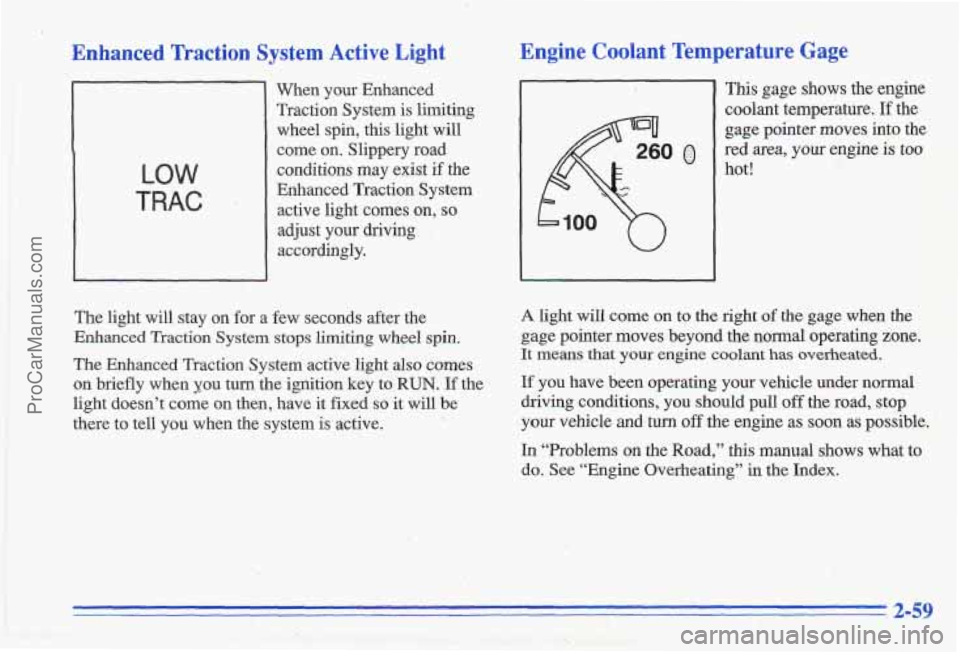
Enhanced Traction System Active Light
LOW
TRAC
When your Enhanced Traction System is limiting wheel spin, this light will
come on. Slippery road
conditions may exist
if the
Enhanced Traction System
active light comes on,
so
adjust your driving
accordingly.
The light
will stay on for a few seconds after the
Enhanced Traction System stops limiting wheel spin.
The Enhanced Traction System active light also comes
on briefly when you turn the ignition key to RUN. If the
light doesn’t come on then, have it fixed
so it will be
there to tell you when the system is active.
Engine Coolant Temperature Gage
This gage shows the engine
coolant temperature.
If the
gage pointer moves into the
red area,
your engine is too
hot!
A light will come on to the right of the gage when the
gage pointer moves beyond the normal operating zone.
It means that
your engine coolant has overheated.
If you have been operating your vehicle under normal
driving conditions, you should pull
off the road, stop
your vehicle and turn off the engine as soon as possible.
In “Problems on the Road,” this manual shows what to
do. See “Engine Overheating” in the Index.
2-59
ProCarManuals.com
Page 116 of 356

Low Coolant Warning Light
; I’ ,.
If this light comes on and
stays on, the vehicle should
be promptly pulled
off the
road and the coolant level
checked.
See “Engine
Coolant”
in the Index.
Malfunctilon Indicator Lamp
(Check Engine Light) ~ ..
0
CHECK
Your Pontiac is equipped
with a computer
which
monitors operation of the
fuel, ignition and emission
control systems.
If there are visible signs of steam see “Engine
Overheating” in the
Index before opening the hood. , . ’? --+ -- This system is called OBD I1 (On-Board .>. ’ I .;: . , Diagnostics-Second Generation) and is intended to
.-. . assure that emissions are at acceptable levels for the
life of the vehicle, helping to produce a cleaner
environment.
(In! Canada, OBD 11 is replaced by
Enhanced Diagnostics.) The CHECK ENGINE light
comes on to indicate that there is a problem and service
is required, Malfunctions often will
be indicated by the
system before
any problem is apparent, which may
prevent more serious damage to your vehicle. This
system is
also designed to assist your service technician
d . in correctly diagnosing any malfunction.
.. .? ’. .. .- . .. i - ,, , c < -. , ,. t :. . ‘7 -n. 9’ .! , . ‘i :- -:x: :, -’ ::;.- . b- .. ,- , . .. .. . : .. -. I. . :. ‘1 .’ ’ E -, . - . r_ :. .. . I. , I -.. . I .C . .. . . .. . .-..-‘ >: =: , , ‘. .. -; T‘.
’ ““2-60
ProCarManuals.com
Page 187 of 356
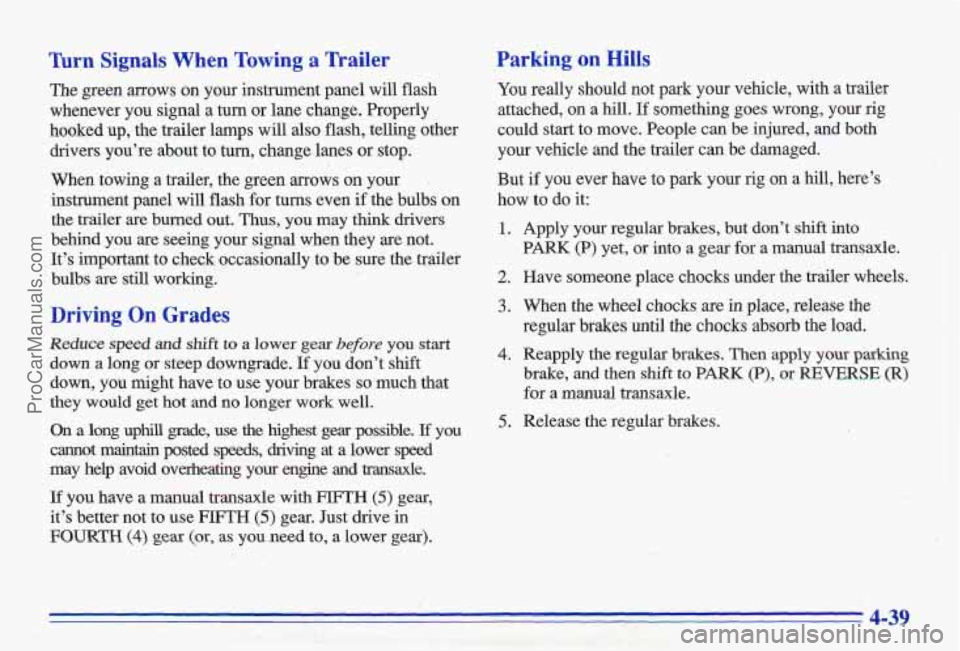
Turn Signals When Towing a Trailer
The green arrows on your instrument panel will flash
whenever you signal a turn or lane change. Properly
hooked up, the trailer lamps
will also flash, telling other
drivers you’re about to
turn, change lanes or stop.
When towing a trailer, the green arrows
on your ’.
instrument panel will flash for turns even if the bulbs on
the trailer are burned out. Thus, you may think drivers
behind you are seeing your signal when they are not.
It’s important to check occasionally to be sure the trailer
bulbs are still working.
Driving On Grades
Reduce speed and shift to a lower gear before you start
down a long or steep downgrade. If you don’t shift
down, you might have to use your brakes
so much that
they would
get hot and no longer work well.
On a long uphill grade, use the highest gear possible. If you
cannot maintain posted speeds, driving at a lower speed
may help avoid overheating your engine and bxmsaxle.
If you have a manual transaxle with FWTH (5) gear,
it’s better not to use
FIFTH (5) gear. Just drive in
FOURTH (4) gear (or- as vou need to, a lower gear).
Parking on Hills
You really should not park your vehicle, with a trailer
attached, on a
hill. If something goes wrong, your rig
could start to move. People can be injured, and both
your vehicle and the trailer can be damaged.
But if you ever have to park your rig on a hill, here’s
how to
do it:
1.
2.
3.
4.
5.
Apply your regular brakes, but don’t shift into
PARK (P) yet, or into a gear for a manual transaxle.
Have someone place chocks under the trailer wheels. When the wheel chocks are in place, release the
regular brakes until the chocks absorb
the load.
Reapply the regular brakes. Then apply your
parking
brake, and then shift to PARK (P), or REVERSE (R)
for a manual transaxle.
Release the regular brakes.
4-39
ProCarManuals.com
Page 202 of 356
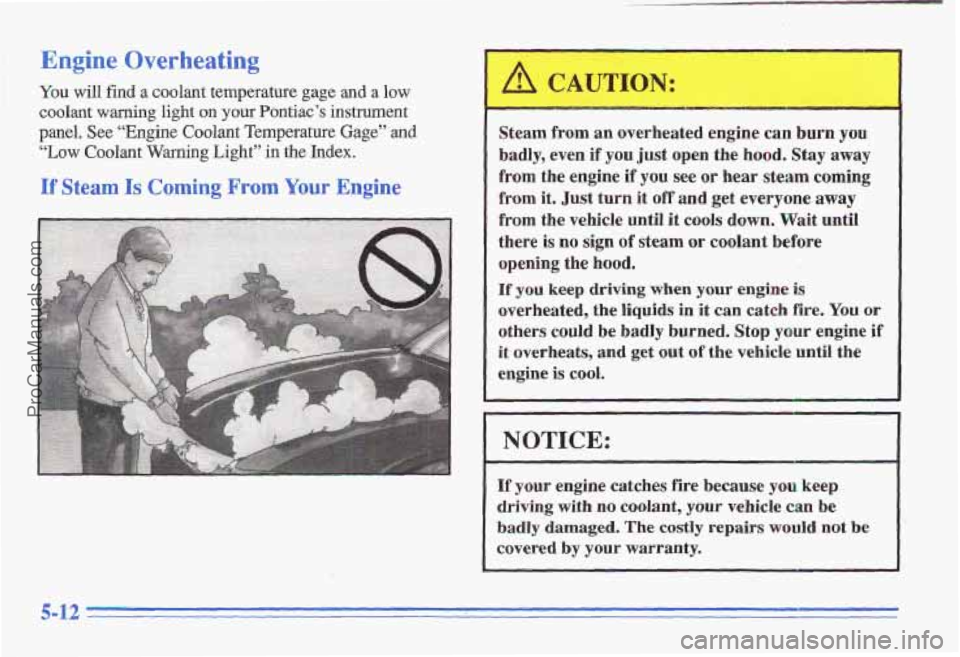
Engine Overheating .
You will find a coolant temperature g.age and a low
coolant warning light on your Pontiac’s instrument
panel. See
“Engine Coolant Temperature Gage” and
“Low Coolant Warning Light” in the Index.
If Steam Is Coming From Your Engine
Steam from an overheated engine can burn you
badly, even if you just open the hood. Stay away
from the engine if you
see or hear steam coming
~ from it. Just turn it off and get everyone away
from the vehicle until it cools down. Wait until
there
is no sign of steam or coolant before
opening the
hood,
If you keep driving when your engine is
overheated, the liquids in it can catch fire, You or
others could
be badly burned. Stop your engine if
it overheats, and get out of the vehicle until the
engine is cool.
1 NOTICE:
~ ~~
If your engine catches fire because you keep
driving with no coolant, your vehicle can be
badly damaged. The costly repairs would not be
covered by your warranty.
5-12
ProCarManuals.com
Page 203 of 356
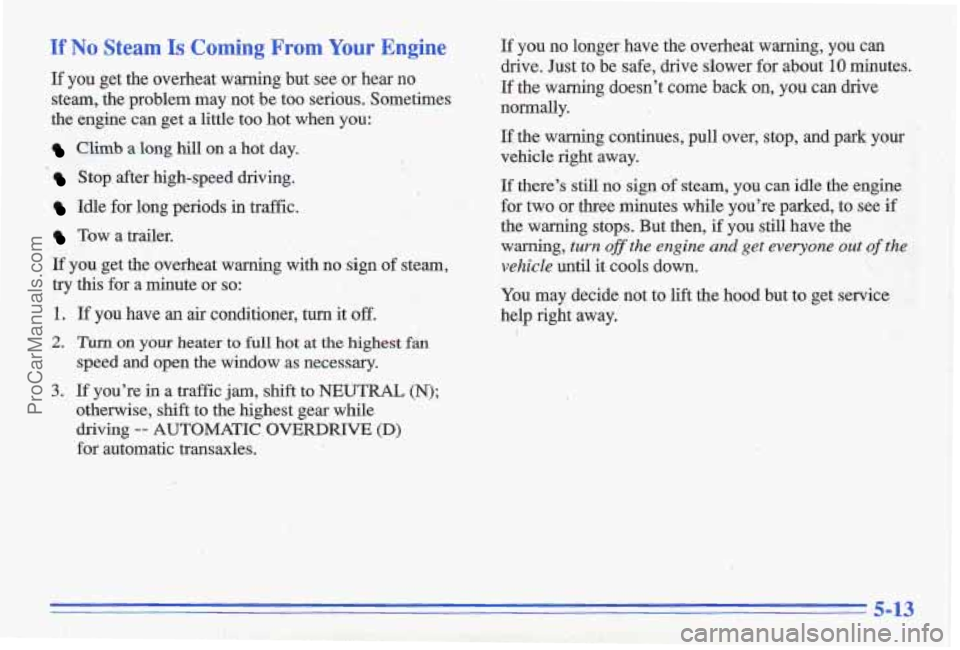
If No Steam Is Coming From Your Engine
If you get the overheat warning but see or hear no
steam, the problem may not b'e too serious. Sometimes
the engine can get a little too hot when you:
Cbb a long hill on a hot day.
' Stop after high-speed driving.
Idle for long periods in traffic.
Tow a trailer.
If you get the overheat warning with no sign of steam,
try this for a minute or so:
1. If you have an air conditioner, turn it off.
2. Turn on your heater to full hot at the highest fan
speed and open the window as necessary.
3. If you're in a traffic jam, shift to NEUTRAL (N);
otherwise, shift to the highest gear while
driving
-- AUTOMATIC OVERDRIVE (D)
for automatic transaxles. ;+, 1; , !, -.,.r., . .-I? ,*:, I,3 : 1 I' ' . . :4?,+ . .I .
If you no longer have the overheat warning, you can
drive. Just to be safe, drive slower for about 10 minutes.
If the warning doesn't come back on, you can drive
normally.
If the warning continues, pull over, stop, and park your
vehicle right away.
If there's still no sign of steam, you can idle the engine
for two or three minutes while you're parked, to see
if
the warning stops. But then, if you still have the
warning,
turn ojf the engine and get everyone out of the
vehicle
until it cools down.
You may decide not .to lift the hood but to get service
help right 'away.
5-13
ProCarManuals.com